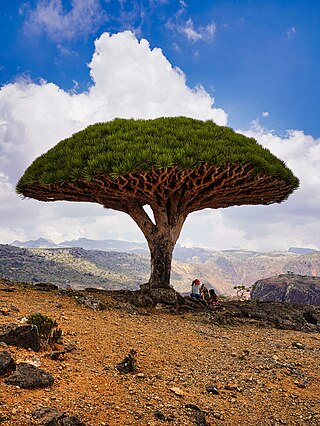
Adenium obesum, more commonly known as a desert rose, is a poisonous species of flowering plant belonging to the tribe Nerieae of the subfamily Apocynoideae of the dogbane family, Apocynaceae. It is native to the Sahel regions south of the Sahara, tropical and subtropical eastern and southern Africa, as well as the Arabian Peninsula. Other names for the flower include Sabi star, kudu, mock azalea, and impala lily. Adenium obesum is a popular houseplant and bonsai in temperate regions.
Paracalyx balfourii is a species of legume in the family Fabaceae. It is a shrub or tree endemic to Socotra and Samhah in the Socotra Archipelago of Yemen. Its natural habitats are subtropical or tropical dry forests and rocky areas.
Lepturus pulchellus is a species of grass in the family Poaceae. It is a perennial endemic to the islands of Socotra and Samhah in Yemen's Socotra Archipelago. It grows in coastal dwarf shrubland on Socotra, and in desertic foothills on Samhah, from 10 to 200 metres elevation.
Hypericum fieriense is a species of flowering plant in the St. John's wort family Hypericaceae. It is endemic to Socotra, an island archipelago that is part of Yemen. It grows in mountain shrubland dominated by Cephalocroton, where it can be found with the endemic tree Dracaena cinnabari. It is rarer than other local shrubby Hypericum species. It can be distinguished from them by its pubescent herbage.

Allophylus is a genus within the plant family Sapindaceae. It includes 211 species with a pantropical distribution.
Allophylus hispidus is a species of plant in the family Sapindaceae. It is endemic to Sri Lanka.
Allophylus rapensis is a species of plant in the family Sapindaceae. It is a shrub or tree endemic to the island of Rapa Iti, in the Tubuai Islands of French Polynesia.
Andrachne schweinfurthii is a species of plant in the family Phyllanthaceae. It is a subshrub native to Somalia and to the island of Socotra, which is part of Yemen. Its natural habitats are tropical dry forests and woodlands and rocky areas.
Limonium paulayanum is a species of plant in the family Plumbaginaceae. It is a subshrub or shrub endemic to Yemen's Socotra Archipelago, where it is native to the islands of Socotra, Samhah, and Abd al Kuri. Its grows in coastal dwarf shrubland and on inland cliffs and rocky areas, from sea level to 550 metres elevation.
Limonium sokotranum is a species of plant in the family Plumbaginaceae. It is a subshrub or shrub endemic to Yemen's Socotra Archipelago, where it is native to the islands of Socotra, Samhah, and Abd al Kuri. Its grows in coastal dwarf shrubland and inland cliffs and rocky areas from sea-level to 550 metres elevation.
Lycium sokotranum is a species of flowering plant in the nightshade family, Solanaceae, that is endemic to the Socotra archipelago in the Indian Ocean (Yemen). It is a spiny, much-branched shrub that is <2 m tall. It is widespread and often abundant on coastal plains and limestone plateaus of Socotra and on the central plains of Abd al Kuri.
Oldenlandia pulvinata is a species of plant in the family Rubiaceae. It is a cushion-forming subshrub endemic to the islands of Socotra, Abd al Kuri, and Samhah in Yemen's Socotra Archipelago. It is widespread in shrubland and in rocky areas on plains and limestone plateaus from sea level to 800 metres elevation.

Dirichletia virgata, synonym Placopoda virgata, is a species of plant in the family Rubiaceae. It is a shrub endemic to the islands of Socotra and Samhah in Yemen's Socotra Archipelago. It is widespread plant in low-elevation shrublands and woodlands, including Croton socotranus shrubland and drought-deciduous woodland, on coastal plains, dry foothills, and limestone plateaus from 10 to 600 metres elevation.
Priva socotrana is a species of plant in the family Verbenaceae. It is a subshrub endemic to the islands of Socotra and Samhah in Yemen's Socotra Archipelago. It is common and widespread in dry shrublands and woodlands on limestone escarpments and plateaus from 50 to 950 metres elevation.
Convolvulus semhahensis is a species of plant in the family Convolvulaceae. It is endemic to the island of Samhah in Yemen's Socotra Archipelago. It grows in open dwarf shrubland with Atriplex griffithii from 100 to 200 metres elevation.

The Socotra Island xeric shrublands is a terrestrial ecoregion that covers the large island of Socotra and several smaller islands that constitute the Socotra Archipelago. The archipelago is in the western Indian Ocean, east of the Horn of Africa and south of the Arabian Peninsula. Politically the archipelago is part of Yemen, and lies south of the Yemeni mainland.

Dracaena cinnabari, the Socotra dragon tree or dragon blood tree, is a dragon tree native to the Socotra archipelago, part of Yemen, located in the Arabian Sea. It is named after the blood-like color of the red sap that the trees produce. It is considered the national tree of Yemen.

The Socotra Archipelago, officially the Socotra Archipelago Governorate, abbreviated to Socotra Governorate, is one of the governorates of Yemen. It includes a number of islands in the Indian Ocean south of mainland Yemen, the largest of which is Socotra.
The wildlife of Yemen is substantial and varied. Yemen is a large country in the southern half of the Arabian Peninsula with several geographic regions, each with a diversity of plants and animals adapted to their own particular habitats. As well as high mountains and deserts, there is a coastal plain and long coastline. The country has links with Europe and Asia, and the continent of Africa is close at hand. The flora and fauna have influences from all these regions and the country also serves as a staging post for migratory birds.
Allophyllus rubifolius is a species of flowering plant in the family Sapindaceae. It is a shrub or tree native to eastern, east-central, and southeastern Africa, ranging from Eritrea to Democratic Republic of the Congo and Kwazulu-Natal, and to the Arabian Peninsula.






